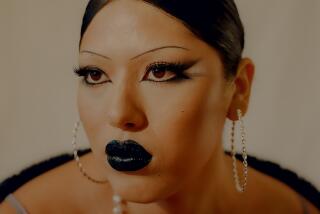Eyebrows That Take the Narrow View
- Share via
Time to say goodby to bushy eyebrows. The Au Naturel brow was at an alltime high in the ‘70s, when nothing could come between Brooke Shields and her Calvins, and it was revived with Madona’s bushier-than-thou brow in the early ‘80s.
But the look for spring/summer is quality versus quantity, with a thinner, more refined style than in the past.
High-brow society: The tendency to pencil and pluck is nothing new. Egyptians of the 14th Century darkened their brows with heavy kohl made from carbon and other materials. The powder was applied with a stick of glass, ivory, metal or wood. Images of King Tutankhamen show brows heavily kohled and extended to the temple and ear, paralleling the line of the eye.
Eyebrow tweezers were among the archeological finds at Ur, an ancient Sumerian city along the Euphrates in southern Iraq. The desire to pluck carried over into the 15th Century, when women desired a thin line over the eyes to complete the “no-hair look” created by shaving the forehead, temple and nape.
Women of the 19th Century carried “Chinese boxes” containing papers of different hues (including black for the eyebrows) for touch-ups on the go. Twentieth Century sirens of the silent screen--from Clara Bow to Greta Garbo--made dramatic entrances with exaggerated eyes and drawn-on brows. In the talkies, Marlene Dietrich served as the barometer for the highs and lows of brow-line location.
For the up-to-date woman, brows are angular, arched, elongated and widely spaced. High-definition brows frame the eyes of today’s top models; Evangelista, Campbell and Turlington strut their penciled-in one or two for the camera. The look is polished, perfect and contrived.
Just browsing: Heavily penciled brows give ‘40s feminine charm to modern menswear dressing. The controlled arch reminiscent of the ‘50s gives studied glamour to the casual American look. And the narrow elongated brow pays homage to the hippie-trip, soul sister and ragamuffin supreme of the ‘60s and ‘70s.
Drawing the brow above the actual brow line leaves more room for color and gives that wide-eyed look. Dark brows and light hair is reminiscent of Marilyn Monroe sex appeal, whereas dark hair and bleached brows stress high contrast and New-Age eyes. If the dramatic look is out of sync with your style, then match the brow to your hair color (or go lighter) for a natural look.
Use a pencil for easy precision, a powder for a softer look (this may be more difficult to apply) or a liquid (with brush) for shimmering control.
White shadow or powder just below the brow accents the shape. Basic Brow-Shaping 1. Length: Brows should start just above the inner corner of the eye and extend slightly past the outer corner. Remove hairs in the area between your eyes by plucking in the direction of hair growth. 2. Arch: Usually begin at the outside corner of the colored part of the eye. Do not tweeze or wax upper brow portion. Limit hair removal to the underside of the brow only. Problem brows Having a professional shape your brows initially will make it easier to maintain the shape yourself with occasional tweezing.
Waxing may be a viable alternative for the bushy-eyed, and bleaching works for the “barely there” look. Or, instead of going to such extremes, you can cover a light brow with powder. Minimizing pain Plucking brows immediately after bathing. The warmth and moisture expand the pores and make hair easier to remove.
Tweeze hair in the same direction as ti grows. Tweezers come with needlelike tips for precision or square edges for a safer pluck.
Use magnifying mirror and slant-edged tweezers
After tweezing, apply astringent to brow area to prevent infection. Next, dab on a little moisturizer to minimize irritation. Tweezers Not Created Equal A good pair of tweezers is hard to find, according to Richard Stevens of Stevens & Cross Cosmetic Studio in Newport Beach. Construction quality varies, even among seemingly identical pairs. When shopping for tweezers, squeeze the tips together to make sure the ends meet, since many of them don’t. “Bad tweezers make the process slow and painful,” said Stevens.
Edges and grips vary among tweezer types. The scoop on four commonly available tweezers: A. Angled: Grasps fine hairs. B. Straight edge: Good for plucking coarse hairs. C. Rounded: Easiest to maneuver quickly, therefore less painful. Grasps fine hairs. D. Square-edge scissors grip: Possibly more painful, since grip forces slow, methodical plucking. Source: “Real Beauty ...Real Women,” by Kathleen Walas
More to Read
Only good movies
Get the Indie Focus newsletter, Mark Olsen's weekly guide to the world of cinema.
You may occasionally receive promotional content from the Los Angeles Times.







